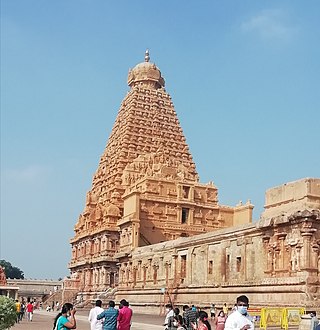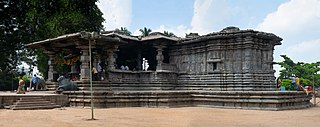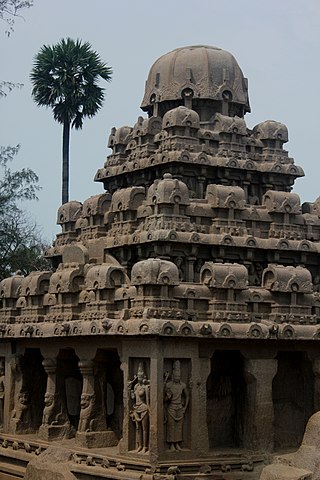
Andhra Pradesh is a state on the east coast of southern India. It is the seventh-largest state and the tenth-most populous in the country. Telugu is the most widely spoken language in the state, as well as its primary official language. Amaravati is the state capital, while the largest city is Visakhapatnam. Andhra Pradesh shares borders with Odisha to the northeast, Chhattisgarh to the north, Karnataka to the southwest, Tamil Nadu to the south, Telangana to northwest and the Bay of Bengal to the east. It has the second-longest coastline in India at about 974 kilometres (605 mi).

The Great Living Chola Temples is a UNESCO World Heritage Site designation for a group of Chola dynasty era Hindu temples in the Indian state of Tamil Nadu. The temple at Thanjavur was added in the list in 1987, while the other two temples were added in 2004.

Ramappa Temple, also known as the Rudreshwara temple, is a Kakatiya style Hindu temple dedicated to the Hindu god Shiva, located in Palampet village, Mulugu district, Telangana, India. It is 15 km (9.3 mi) from Mulugu, 66 km (41 mi) from Warangal, 209 km (130 mi) from Hyderabad. An inscription in the temple says it was constructed in the year 1213 CE by Recharla Rudra Reddy—a general of Kakatiya ruler Ganapati Deva. Located in the vicinity of Ramappa Lake, the Ramappa Temple complex which consist of three temples was constructed between 1212 and 1234, designed and architect by Ramappa—after whom the temple complex is named. Marco Polo, during his visit to the Kakatiya empire, supposedly called the temple "the brightest star in the galaxy of temples". In July 2021, Ramappa Temple was declared as a UNESCO World Heritage Site.

Veerabhadra temple is a Hindu temple located in the Lepakshi, in the state of Andhra Pradesh, India. The temple is dedicated to the Virabhadra, a fierce form of the god Shiva.

Indian rock-cut architecture is more various and found in greater abundance in that country than any other form of rock-cut architecture around the world. Rock-cut architecture is the practice of creating a structure by carving it out of solid natural rock. Rock that is not part of the structure is removed until the only rock left makes up the architectural elements of the excavated interior. Indian rock-cut architecture is mostly religious in nature.

Vijayanagara architecture of 1336–1565 CE was a notable building idiom that developed during the rule of the imperial Hindu Vijayanagara Empire. The empire ruled South India, from their regal capital at Vijayanagara, on the banks of the Tungabhadra River in modern Karnataka, India. The empire built temples, monuments, palaces and other structures across South India, with the largest concentration in its capital. The monuments in and around Hampi, in the Vijayanagara district, are listed as a UNESCO World Heritage Site.

Brihadishvara Temple, called Rajarajesvaram by its builder, and known locally as Thanjai Periya Kovil and Peruvudaiyar Kovil, is a Shaivite Hindu temple built in a Chola architectural style located on the south bank of the Cauvery river in Thanjavur, Tamil Nadu, India. It is one of the largest Hindu temples and an exemplar of Tamil architecture. It is also called Dakshina Meru. Built by Chola emperor Rajaraja I between 1003 and 1010 CE, the temple is a part of the UNESCO World Heritage Site known as the "Great Living Chola Temples", along with the Chola-era Gangaikonda Cholapuram temple and Airavatesvara temple, which are about 70 kilometres (43 mi) and 40 kilometres (25 mi) to its northeast respectively.

The Thousand Pillar Temple or Rudreswara Swamy Temple is a historical Hindu temple located in the town of Hanamakonda, Telangana State, India. It is dedicated to Lord Shiva, Vishnu and Surya. Thousand Pillar Temple, along with Warangal Fort and Kakatiya Kala Thoranam are added to the tentative list of World Heritage sites recognised by UNESCO.

Unakoti famously known as Angkor Wat of the North-East, is a sculptural emblem and ancient Shaivite place that hosts rock carvings, figures and images of gods and goddesses. It is a place of worship with huge rock reliefs celebrating Shiva. Unakoti literally means "one less than one crore" or "koti" in Hindi. In the local Kokborok language, it is called Subrai Khung. It was put on the UNESCO world heritage site tentative list in 2022. It is the prime tourist spot of Unakoti District, in the Kailashahar Subdivision of the North-eastern Indian state of Tripura.

The Duladeo Temple is a Hindu temple in Khajuraho, Madhya Pradesh, India. The temple is dedicated to the god Shiva in the form of a linga, which is deified in the sanctum. 'Dulodeo' means "Holy Bridegroom". The temple is also known as "Kunwar Math". The temple faces east and is dated to 1000–1150 AD. It is the last of the temples built during the Chandela period. The temple is laid in the seven chariot plan (saptarata). The figurines carved in the temple have soft expressive features unlike other temples. The walls have a display of carved celestial dancers (apsara) in erotic postures and other figures. As part of the Khajuraho Group of Monuments, the temple was inscribed on the UNESCO World Heritage List in 1986.

Vamana temple is a Hindu temple dedicated to Vamana, an avatar of the god Vishnu. The temple was built between 1050 and 1075. It forms part of the Khajuraho Group of Monuments, a UNESCO World Heritage Site listed because of its exceptional architecture, art, and testimony to the Chandela dynasty.

Pancha Rathas is a monument complex at Mahabalipuram, on the Coromandel Coast of the Bay of Bengal, in the Chengalpattu district of the state of Tamil Nadu, India. Pancha Rathas is an example of monolithic Indian rock-cut architecture. The complex was initially thought to have carved during the reign of King Narasimhavarman I. However, historians such as Nagaswamy attributed all of monuments in Mahabalipuram to Narasimhavarman II with the discovery of new inscriptions. The complex is under the auspices of the Archaeological Survey of India (ASI) and is part of the UNESCO World Heritage Site inscribed by UNESCO in 1984 as Group of Monuments at Mahabalipuram.

Arjuna Ratha is a monument from the Pallava Period at Mahabalipuram, on the Coromandel Coast of the Bay of Bengal, in Kancheepuram district of Tamil Nadu, India. Dated to the seventh century, it is an example of early Dravidian architecture and of monolith Indian rock-cut architecture dating from the late 7th century during reign of King Mahendravarman I and his son Narasimhavarman I of the Pallava Kingdom. One of the Pancha Rathas, it is believed to have been completed before the Dharmaraja Ratha, and like that and the Bhima Ratha, the stone temple is a replica of an earlier wooden version which preceded it. It is one of the Group of Monuments at Mahabalipuram designated as a UNESCO World Heritage Site since 1984.

Nakula Sahadeva Ratha is a monument in the Pancha Rathas complex at Mahabalipuram, on the Coromandel Coast of the Bay of Bengal, in the Kancheepuram district of the state of Tamil Nadu, India. It is an example of monolith Indian rock-cut architecture. Dating from the late 7th century, it is attributed to the reign of King Mahendravarman I and his son Narasimhavarman I of the Pallava Kingdom. The entire complex is under the auspices of the Archaeological Survey of India (ASI), and is one of the Group of Monuments at Mahabalipuram that were designated as a UNESCO World Heritage Site since 1984.

The Chitragupta temple is an 11th century temple of Surya in the Khajuraho town of Madhya Pradesh, India. Architecturally, it is very similar to the nearby Jagadambi temple. The temple is a part of the Khajuraho Group of Monuments, a World Heritage Site.

Tourism in India is economically significant and projected to continue a pattern of growth. The World Travel & Tourism Council calculated that tourism generated ₹14.02 lakh crore (US$160 billion) or 9.6% of the nation's GDP in 2016 and supported 40.343 million jobs, 9.3% of its total employment. The sector is predicted to grow at an annual rate of 6.8% to ₹28.49 lakh crore (US$330 billion) by 2027.

Jain hoysala complex in Halebidu, Hassan district consists of three Jain Basadis dedicated to the Jain Tirthankars Parshvanatha, Shantinatha and Adinatha. The complex is situated near Kedareshwara temple and Dwarasamudra lake. The temple complex also includes a step well called Hulikere Kalyani.

Danavulapadu Jain temple is an ancient Jain center located in Danavulapadu village, within the Jammalamadugu mandal of Kadapa district in the state of Andhra Pradesh.
Virupanna and Viranna were Nayaka chieftains who built the Veerabhadra Temple in Lepakshi, Andhra Pradesh. They built the Veerabhadra Temple in 1530 AD, which is dedicated to the fiery incarnation of Lord Shiva. The temple is known for its Vijayanagara period architecture and mural paintings.


















